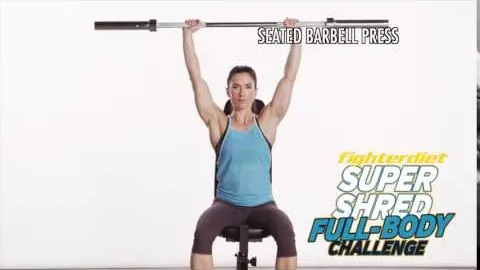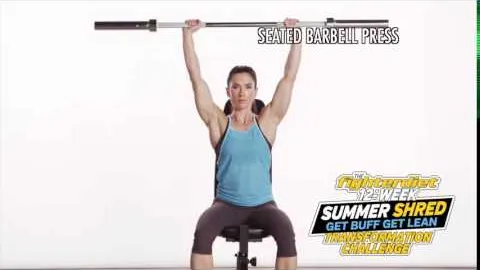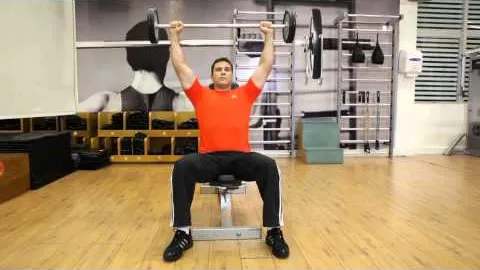



Title: The Ultimate Guide to the Seated Barbell Press Exercise: Benefits, Technique, and Variations
Introduction
The seated barbell press exercise is a compound movement that targets the shoulders and triceps while engaging the core and upper back muscles. Whether you are a beginner or an experienced lifter, incorporating the seated barbell press into your workout routine can help you develop upper body strength, increase muscle mass, and enhance overall shoulder stability. In this guide, we will discuss the numerous benefits of this exercise, proper technique, common mistakes to avoid, and variations that can be incorporated to make your workouts more challenging and effective.
Benefits of the Seated Barbell Press Exercise
Strengthens Shoulder Muscles: The seated barbell press primarily targets the deltoid muscles, specifically the anterior (front) deltoids. By regularly performing this exercise, you can increase shoulder strength, improve posture, and reduce the risk of injuries.
Multi-Joint Movement: The seated barbell press is a compound exercise that involves multiple joints, including the shoulder, elbow, and wrist. This makes it an excellent choice for maximizing muscle recruitment and overall upper body strength development.
Enhances Core Stability: To maintain proper form during the seated barbell press, you must engage your core muscles. This helps improve overall core stability and balance, leading to better performance in other exercises and daily activities.
Increases Triceps Activation: The triceps, located on the back of the upper arm, are heavily involved in the pushing motion of the seated barbell press. Incorporating this exercise into your routine can result in stronger, more defined triceps.
Improves Shoulder Mobility: Performing the seated barbell press with proper technique can help improve shoulder mobility and flexibility. This can be particularly beneficial for athletes involved in sports that require overhead movements, such as basketball, volleyball, or swimming.
Versatile Exercise: The seated barbell press can be modified to accommodate different fitness levels and goals. Whether you are a beginner using lighter weights or an advanced lifter looking to increase muscle mass, this exercise can be easily customized to suit your needs.
Proper Technique
To perform the seated barbell press exercise correctly and minimize the risk of injury, follow these step-by-step instructions:
Setup: Sit on a flat bench with your feet flat on the floor, positioned shoulder-width apart. Grab the barbell with an overhand grip, slightly wider than shoulder-width.
Positioning: Lift the barbell upward, resting it on your upper chest and front deltoids. Ensure your elbows are in line with your wrists and your forearms are perpendicular to the floor. Maintain a neutral spine and engage your core.
Execution: Exhale and push the barbell upward in a controlled manner until your arms are fully extended, but without locking out your elbows. Keep your head aligned with your spine throughout the movement.
Descent: Inhale and gradually lower the barbell back down to the starting position. Maintain control as you bring the barbell down, focusing on the negative portion of the exercise.
Common Mistakes to Avoid
To maximize the effectiveness and safety of the seated barbell press exercise, avoid the following common mistakes:
Arching the Back: Maintain a neutral spine throughout the exercise to avoid excessive pressure on the lower back. Avoid arching your back or leaning backward as you push the barbell upward.
Use of Momentum: Avoid using excessive momentum to lift the barbell. Focus on controlled, deliberate movements to engage the target muscles effectively.
Improper Grip: Ensure your grip on the barbell is firm and secure. Using an incorrect grip can compromise your stability and increase the risk of dropping the barbell.
Overarching the Neck: Avoid hyperextending or jutting your neck forward during the movement. Keep your head aligned with your spine to maintain proper form.
Neglecting a Full Range of Motion: Lowering the barbell too quickly or not extending your arms fully at the top of the movement can limit the benefits of the exercise. Aim for a full range of motion while maintaining control throughout.
Variations of the Seated Barbell Press Exercise
Zigzag Barbell Press: This variation involves using a specialized zigzag barbell, which allows for a slightly different hand position. The zigzag barbell can help alleviate shoulder discomfort for individuals with preexisting shoulder issues.
Single-Arm Dumbbell Press: Instead of using a barbell, perform the exercise using a single dumbbell in each hand. This variation helps improve muscular balance and stability by engaging each side independently.
Seated Barbell Arnold Press: Named after Arnold Schwarzenegger, this variation involves rotating the wrists inward as you push the barbell upward. The Arnold press adds an extra degree of shoulder mobility and provides a unique stimulus to the deltoids.
Conclusion
The seated barbell press exercise is a highly effective compound movement that targets the shoulder muscles while engaging the core and triceps. By incorporating this exercise into your workout routine and following proper technique, you can enjoy a wide range of benefits, including increased upper body strength, enhanced shoulder stability, and improved overall posture. Remember to start with a weight that allows for proper form and gradually increase the load as your strength improves. With regular practice and consistency, you'll experience the transformative effects of the seated barbell press exercise on your physique and overall fitness.
If you're looking for a gym, fitness club or yoga studio, you've come to the right place.
You can find information about gyms in your area. Browse catalog of gyms and find gyms with classes which are you looking for.
On gym page you can find simple information like address, phone or website. You can find list of available classes. You can check availability of personal training or small group classes. On place page you can also see information about open hours.
You can find gyms near you with amenities, courts, studios and equipments.
Use our map to find gym at your city or district.
In Gym Navigator you can find list of exercises with movies for many body parts.
You can browse exercises catalog and find exercises the best of you.
You can also find exercises grouped into workout plans, which you can use to improve you body. Each routine show you exercises one by one and give you possibility to count you progress and count down rest time.